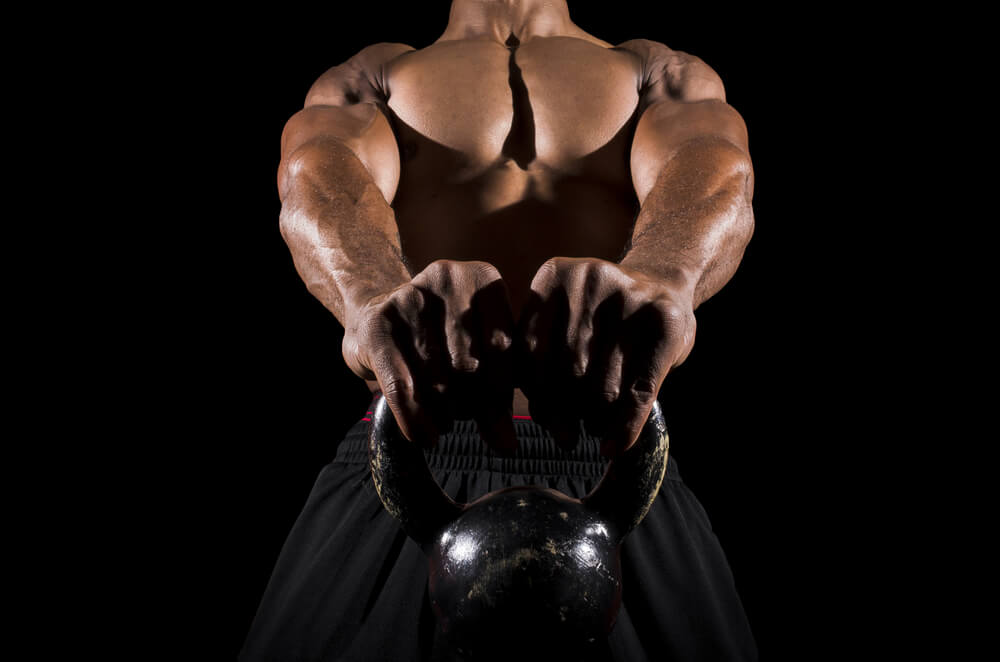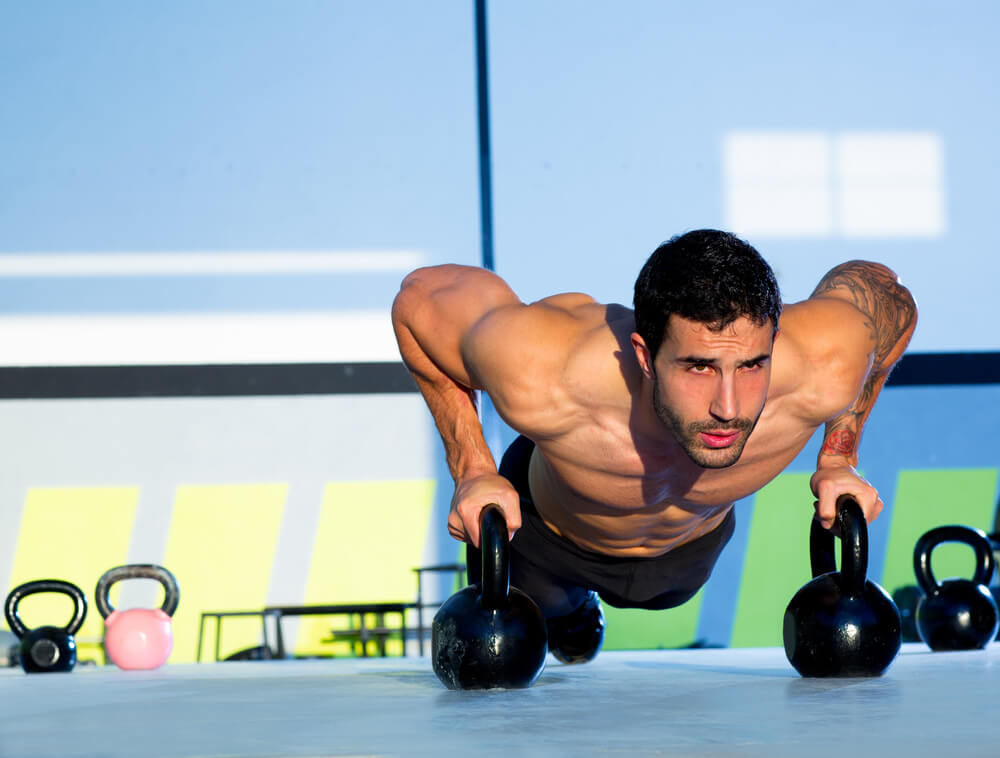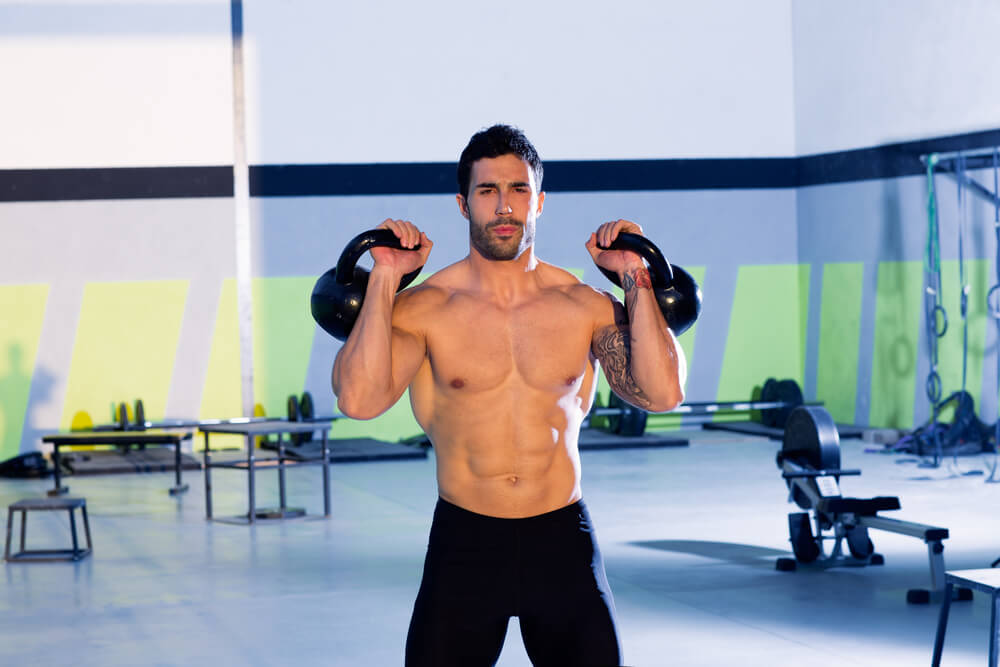
There has been a large surge of Kettlebell exercises. You can thank the Crossfit boxes for re-introducing kettlebells to the fitness world. The reason I say introducing, it’s because kettlebells have been around for hundreds of years.
There are even stories of Spartan warriors training with kettlebells.
In this article, we will explore the age of kettlebells, different ways of using a kettlebell, and how to incorporate them into your training program.

What Are Kettlebells?!
For those who are new to their fitness journey, you might ask what is a kettlebell.
A kettlebell is a cast iron or steel ball with handles. Think of a cannonball with a handle. Different types of kettlebells include bags filled with sand, water, or steel shot. A kettlebell is used for swing movements and release moves with added safety and added grip, wrist, arm and core strengthening.
The unique shape of the kettlebell provides the “unstable force” for handling – key for the effectiveness of the kettlebell exercises. The anatomy of the kettlebell can be broken down into: handle, corner, horn, window, bell, and base.
The uses of a kettlebell are vast in the fitness world. It can be used for strength training, cardiovascular exercises and flexibility training. The earliest recorded history in the uses of kettlebells was in classical Greece.
Kettlebells were also used in the early 18th and 19th centuries in Europe and Russia during strongman competitions. At some point in history kettlebells then made their way to strongmen competitions and the circus.
After World War II, the Soviets adopted the kettlebell as a way to train their soldiers. Shortly after that, the kettlebell had become a sport in the Soviet Union.
So as you can see, kettlebells have been around for some time and only recently they have become popular again due to how available they are now through gyms and online sales.

How to use Kettlebells
Let’s explore the different variations kettlebells are used.
I will discuss some of my favorites and go over some other ones. I will go over some of them and discuss proper form when using kettlebells.
Kettlebell Swing
The kettlebell swing is probably the best kettlebell movement because you use your full body to generate the swing, you get an extreme fat loss and a high level of cardio conditioning. It’s also a foundation movement of all kettlebell exercises.
It may look easy to perform but the form is very important. It takes a lot of time and coaching to perfect. Unfortunately, too many people perform it wrong which leads to injuries that could have been prevented. Doing the exercise wrong will also limit your results as well as limit any other progressions that are based on the movement. Below is a step by step on how to perform a kettlebell swing.
Step 1: Stand with your feet shoulder-width apart with a kettlebell about a foot in front of you on the ground. Bend at the waist and grasp the kettlebell handle with both hands. Your palms should be facing your body, and your torso should be nearly parallel to the ground.
Step 2: Pull your shoulders down and back and brace your core before starting the exercise. Maintain these form cues throughout the entire set.
Step 3: Lift the kettlebell off the ground and allow it to swing between your legs. Your knees should bend slightly during this movement. Keep your back flat and neck straight.
Step 4: Forcefully drive your hips forward to propel the kettlebell into the air. Control the kettlebell with your arms, but don’t pull it up. The kettlebell should travel no higher than your shoulders.
Step 5: Allow the kettlebell to swing down and back through your legs. Control the descent by keeping your core engaged. As the kettlebell lowers, move immediately and fluidly into the next rep.
Step 6: On your final rep, allow it to swing back through your legs, and then place it a foot in front of you on the ground.
Just remember, the kettlebell swing is one of the best exercises you can do. If you really want results, learn to perform it the right way.
Goblet Squats
Squatting is a movement that is fundamental to any lifter, bodybuilder, and all-around athlete. The kettlebell goblet squat isn’t just a leg workout. It’s a full body workout that works your core, mobility and improves conditioning. There is no denying that the barbell squat is king of strength training but the goblet squat is a great addition to your leg routine.
Step 1: Standing tall with your feet shoulder-width apart, grab the head of a dumbbell with both hands and hold it vertically in front of your chest.
Step 2: Keeping your back straight, squat down until the crease of your hip drops below the knee and the tops of your thighs are at least parallel to the floor. Extend your hips and knees to return to the starting position.
As you can tell, it is a simple exercise to add to your routine.
Turkish Get-Ups
The Turkish Get-Up (TGU) is a slow, deliberate movement that’s been around for a long time. If you’re looking for an exercise to challenge you, this is it. It’s a full body movement that requires you to focus every part of your body and to respect what your body is capable of. It strengthens your shoulders, arms, chest, core etc.
Step 1: Move the bell so the arm is perpendicular to the floor, either using one hand or both. Some people choose to add a single-arm press, but it’s extra credit and not the norm, especially once the weights get heavy. A two-handed pistol-grip press is just fine.
Lockout the elbow, and pull the loaded shoulder into its socket. Bend the knee on the side of the body that’s holding the kettlebell. Place the opposite arm on the floor approximately 45 degrees from the body.
Step 2: Take a deep breath and hold it. Drive from the foot on the working side, roll up onto your elbow, and exhale. Once you’re stable at the elbow, roll up onto your hand. Don’t go straight to your hand. It is very important to follow this step by step.
Step 3: Squeeze your glutes and lift your hips off the ground high enough to be able to move your outstretched leg under your body. You’ll support yourself on one arm, the heel of the straight leg, and the surface of your flat foot, like a tripod. Keep your arm extended totally vertically. When the weights get heavy, you’ll know why.
Step 4: Take your straight leg and pull or sweep it under your body, placing it next to and behind the hand on the floor. You’ll end up in a position that makes your legs appear to be 90 degrees from each other. One knee will be pointing straight ahead, and the other should point directly at the hand on the floor. Keep your neck rotated upward, looking up at the kettlebell in your hand.
Step 5: Take your support hand off the floor and move your body upright, keeping the kettlebell overhead. At this point, shift your gaze so you are looking straight ahead. “Windshield wiper” the leg that’s on the ground so that both legs are now parallel to each other, in a lunge position. Drive from your back foot, through your hips, and into your front foot, standing up from the lunge.
Keep looking forward!
Step 6: While still looking forward, step back into the lunge so that your knee is on the floor. “Windshield wiper” the back leg to perpendicular from the front leg. Fold into your hips and place your hand just in front of the knee on the floor. Stick your leg straight out in front of you and put your butt on the floor. Roll down to your elbow, and then down onto your shoulders and back. Lower the kettlebell with two hands to your stomach, then roll to your side and place the weight on the floor.

Kettlebells in your Routine
Here is an easy warm-up that you can do by just using kettlebells.
3 rounds
15 Kettlebell Swings
15 Kettlebell Lunges
15 Goblet Squats or air squats
Now a one day example of just using kettlebells for a weightlifting routine:
Chest/back
Kettlebell Chest Press 3×10-12
Kettlebell Incline Press 3×10-12
Dumbbell Fly 3×10-12
Dumbell Incline Hammer Press 3×10-12
Two Arm Kettlebell Row 3×10-12
One Arm Kettlebell Lateral Raise 3×10-12
Kettlebell Press 3×10-12
One Arm Supine Kettlebell Row 3×10-12
As you can see, the routines can be fairly simple but will work you hard. Kettlebells are a different kind of lift because of the way they are made, it’ll force you to engage your core a lot more.
Conclusion
We went over some history and some routines using the kettlebell. There are plenty of other exercises for you to explore and try. It’s easy to add to your routines. You add them to your cardio routine, such as HIIT, or add them to your strength training. Do some kettlebell swings as part of your warm up. There are so many different variations of kettlebell workouts that you should be able to do an entire training session by just using kettlebells.
Kettlebells will supplement any of your routines. Challenge yourself, get out of your comfort zone, try a new routine, add kettlebells to it and reap the rewards of strength and conditioning.
-Detective Ayman Kafel
Latest posts by Terry M (see all)
- Garage Gyms - Aug 1, 2018
- Kettlebells – Why They Should Be Added To Your Routine. - Jul 24, 2018
- Weight Belts: What Are They Really For? - May 31, 2018









Nice info about kettlebells..
This will surely help those who are into bodybuilding and figure enthusiast. I think the article laid down the importance of using this tool as well as the other tools present within the gym to level up the progress on their body.
Thank you for sharing this useful information, I will regularly follow your blog
[…] 29, 2018 Facebook Twitter Google+ Pinterest […]